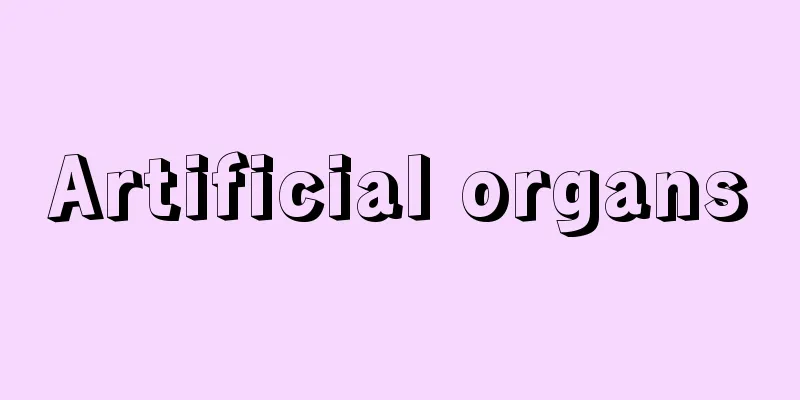Artificial organs

|
A general term for artificial devices that are used to replace organs or tissues in living organisms. Replacement surgery is a method of fundamentally treating organs that have lost their function due to disease or damage by replacing them with organs from other living organisms or with artificial machines. Within replacement surgery, organ transplantation is the use of organs from living organisms, while artificial organs are the use of artificial machines. If an organ transplant is successful, the donated organ will take root in the body and function almost perfectly. Moreover, the patient's living conditions will be physiological, and they will be able to move freely, making it far more comfortable and advantageous than artificial organs. However, organ transplants have many medical and social issues to be resolved, such as obtaining the organs, preserving them, and determining the donor's death. Until now, only kidney transplants (removal of kidneys from cadavers) have been legally recognized as important human organ transplants. However, in July 1997, the Organ Transplant Law was enacted, which made it possible to transplant organs from brain-dead donors, and paved the way for organ transplants from brain-dead donors. On February 28, 1999, the first heart transplant from a brain-dead donor was performed at Osaka University in Japan after the Organ Transplant Law came into effect. In May and June 1999, similar heart transplants were performed at the National Cerebral and Cardiovascular Center, and all three were successful. Since then, 20 heart transplants have been performed, with a 5-year survival rate of 90%, which is high compared to other countries. As of the end of 2006, Japan has performed approximately 4,300 living donor partial liver transplants using family members as a unique procedure. Organ transplants and artificial organs coexist. If a kidney transplant fails, an artificial kidney can be used to wait for the next donor. In the heart transplant case mentioned above, an auxiliary artificial heart was implanted in the body to maintain cardiac function. Although the way for organ transplantation has been opened, there are many people in Japan who cannot accept organ transplants from brain-dead donors, and various social problems remain. This tendency is particularly strong in Japan and other Asian countries, where social conventions differ from those in the West. If ideal artificial organs could be developed for organ transplantation, not only would these social problems be solved, but they would also become possible to mass-produce and store for long periods, allowing them to be used anytime, anywhere, by anyone. In this way, artificial organs have many advantages that organ transplants do not have. It is technically no easy task to create artificial organs that have the same complete functions as living organs, are small, can withstand long-term use, and can be placed inside the body, but efforts are underway. [Kazuhiko Atsumi] Classification of artificial organs and the research and development processCurrently, research is being conducted on artificial organs in almost every field except the brain, stomach, and endocrine organs. In medicine, there is no need to artificially create and replace the brain, which is the core of human existence, and endocrine organs can be substituted by administering hormones. Below is a list of the main artificial organs currently being developed. Artificial skin, artificial skull, artificial dura mater, artificial eyeball, artificial vision, artificial ear, artificial hearing, artificial nose, artificial bone, artificial joint, artificial tendon, artificial muscle, artificial blood vessel, artificial heart-lung machine, artificial lung, artificial trachea, artificial esophagus, artificial valve, artificial heart, artificial (cardiac) pacemaker, artificial liver, artificial bile duct, artificial intestine, artificial pancreas, artificial kidney, artificial ureter, artificial bladder, artificial urethra, artificial fallopian tube, artificial uterus, artificial blood, artificial hand, artificial foot. A perfect artificial organ is a perfect substitute for a living organ. In other words, it is in the same anatomical position as the living organ, is about the same size, and can completely substitute for the function of the target organ. However, it is impossible to completely satisfy these conditions. For this reason, research on artificial organs began with the creation of organ models, with the main goal of substituting the function of the organ, regardless of the size, shape, or location of the organ. The research and development process is as follows: At the beginning of the research, a model is created that can partially substitute for the function of the target organ in the short term, and then further improvements are made to create a model that can completely substitute for that function in the long term. Eventually, the function of the artificial organ is tested, animal experiments are conducted, and it is applied to clinical practice. The artificial organ is then made smaller and more portable, and finally completed into something that can be built into the body. [Kazuhiko Atsumi] New developments in artificial organsInnovation in artificial organs
(2) Complete substitution of the functions of artificial organs Conventional artificial kidneys merely remove some of the waste products and toxins from the blood through dialysis. However, since around 1998, research has been conducted to mimic the filtering and secretion mechanisms of living kidneys. Regarding artificial hearts, studies are being conducted on automatic regulation or control mechanisms that are physiologically closer to those of living hearts, and regarding artificial livers, research is also being conducted on metabolic bioreactors (artificial reactors intended to substitute for the metabolic functions of living organisms) through the cultivation of hepatocytes or the immobilization of enzymes. In this light, it can be said that future artificial organs are moving in the direction of how they can come as close as possible to living organs by perfecting the substitution of functions. (3) Miniaturization of artificial organs In current artificial hearts, only the blood pump is implanted inside the body or attached to the body wall, and the devices required to operate it, such as the air pressure drive, measurement, control, and energy source, are placed outside the body because they are large. However, the future goal is to develop a built-in completely artificial heart in which all these devices, including the energy source, are implanted inside the body as a system, and research toward this goal is currently underway. Research is also underway to miniaturize artificial kidneys through the development of filter membranes, hollow fibers, and adsorbents, as well as research into microcapsules and immobilized enzymes. Portable artificial kidneys have already reached the practical stage, and attempts are being made to develop wearable artificial kidneys, but the ultimate goal is to have them built into the body, and basic research into this is also underway. [Kazuhiko Atsumi] Development of non-life-saving artificial organsConventional artificial organs, whether they be artificial blood vessels, artificial valves, or artificial kidneys, were essentially artificial versions of primary vital organs that were directly related to the life or death of the patient. In other words, without these artificial organs, the patient could not hope to survive. In that sense, it can be said that the greatest goal of artificial organs up until now has been life-saving treatment for organs. However, since around 1980, research and development of artificial organs has been progressing in many fields, including artificial sensory devices such as artificial vision and artificial hearing, as well as artificial pancreases, artificial bladders, and artificial arms. Although these do not directly relate to the life or death of humans, they would be considered desirable if they existed. [Kazuhiko Atsumi] New developments in artificial organ technologyIn the filtration method of artificial kidneys, the pore size of the filtration membrane is increased, allowing plasma to be filtered through the blood. Using this technology, it is possible to remove immune complexes contained in plasma. This is utilized in a new treatment for incurable diseases called plasma exchange. At the beginning of research, plasma from other people was used as a supply, but since around 1980, it has become possible to return the patient's plasma as is to the patient after removing the target substances. In other words, a new development has taken place, from the filtration method of artificial kidneys to plasma exchange. [Kazuhiko Atsumi] Development of medical methodologySince artificial organs imitate and substitute for the functions of living organs, it goes without saying that their research is useful for elucidating the essential functions of living organs. In other words, by analyzing and reducing the differences between living organs and their model artificial organs, the biological functions of the target organ become clear. For example, through research on artificial hearts, we have come to understand why the heart needs pulsatile flow and the significance of the mechanisms of regulating blood flow and blood pressure in the circulatory system, and through research on artificial kidneys and livers, the causative substances of uremia and hepatic coma have been elucidated. Furthermore, the mechanism of blood sugar regulation has been understood through the artificial pancreas, and human movement has been analyzed through artificial hands and legs. There are many other examples to be given. The methodology of research into artificial organs is completely different from conventional methods, and therefore it is expected to make a dramatic contribution to the development of basic medicine in the future. [Kazuhiko Atsumi] Social assessment of artificial organsWhen the use of artificial organs was limited to specialized researchers, only medical and technical issues were issues. However, as their use became more widespread, social issues began to arise. For example, economic issues in the long-term use of artificial kidneys, ethical issues in the clinical application of artificial hearts, and legal issues such as reliability and safety as pacemakers and artificial pancreases became more widespread. In 1969, the National Institutes of Health in the United States conducted a study on social issues related to the clinical application of artificial organs. The social issues addressed various aspects of the field, such as biological, psychological, social, ethical, legal, economic, and administrative. The contents of these studies highlight all the issues facing modern medicine, such as the rebellion of artificial organs against natural selection, the problems of humans living dependent on machines, physical and mental suffering, human rights, maintaining quality of life, evaluation of artificial organs, strategies (methodologies) for clinical application, and the effective allocation of medical resources. Even today, 40 years later, these studies remain extremely interesting. [Kazuhiko Atsumi] "Artificial Organs Today: The State of Cutting-Edge Medical Care in Our Lives," edited by the Japanese Society for Artificial Organs (2007, Haru Shobo)" ▽ "Artificial Organs Illustrated," edited by the same company (2008, Haru Shobo) [Reference items] | | | | -lung machine| | | |Source: Shogakukan Encyclopedia Nipponica About Encyclopedia Nipponica Information | Legend |
|
生体の臓器、あるいは組織の代行を目的として人工的につくられた装置の総称。疾病や損傷によって機能を失い、絶望的になった臓器を他の生体の臓器、あるいは人工の機械で置き換えることによって根本的な治療を行う方法を置換外科という。置換外科のうち、生体の臓器を活用するのが臓器移植であり、人工の機械を用いるのが人工臓器である。 臓器移植が成功すれば、その供給された臓器は体内において生着し、機能もほぼ完全である。しかも、患者の生活状態は生理的で、行動は自由となり、人工臓器に比して比較にならないほど快適かつ有利である。しかし、臓器移植には臓器の入手、臓器の保存、あるいは提供者の死の判定など、医学的および社会的に解決すべき多くの問題があり、これまで人体の重要なる臓器の移植においては、腎臓(じんぞう)移植(死体からの腎臓摘出)が法律的に認められているだけであった。しかし、1997年(平成9)7月に、脳死者からの臓器移植を可能とする法律「臓器の移植に関する法律(臓器移植法)」が成立し、脳死臓器移植の道が開かれた。1999年2月28日に、日本において臓器移植法施行後、最初の脳死の患者をドナーとする心臓移植が大阪大学において行われた。次いで1999年5月および6月に、同じく心臓移植が国立循環器病センターにおいて行われ、3例とも無事成功している。その後、心臓移植は20例行われ、5年生存率は90%と外国に比して高い。なお、日本では、独自のものとして、家族のドナーによる生体部分肝移植が2006年末までに約4300回行われている。臓器移植と人工臓器とは共存の関係にある。もし腎臓移植が失敗しても人工腎臓で次のドナーを待つことができる。前記の心臓移植例においても、体内に補助人工心臓が植え込まれ、心臓機能が維持されていた。 臓器移植の道が開かれたとはいえ、日本では脳死臓器移植を受け入れられない人は少なくなく、さまざまな社会的問題は残っている。この傾向は、欧米とは社会通念が異なる日本および東洋諸国においてとくに強い。臓器移植に対し、もし、理想的な人工臓器が開発されれば、こうした社会的問題は解決されるばかりでなく、大量生産も、長期保存も可能となり、いつでも、どこでも、だれでも使用できることとなる。このように、人工臓器は臓器移植にはない多くの利点を有している。生体の臓器と同じような完全な機能を有し、小型で、しかも長期の使用に耐え、生体内に内蔵しうるような人工臓器をつくりあげることは技術的にもけっして容易ではないが、その努力が進められている。 [渥美和彦] 人工臓器の分類と研究開発のプロセス現在、人工臓器は脳、胃および内分泌器官を除いたほとんどすべての分野において研究がなされている。医療においては、人間の存在の主体である脳を人工的につくり、置き換える必要性はないし、内分泌器官はホルモン剤の投与によって代行することができる。次に現在開発されている、おもな人工臓器をあげる。 人工皮膚、人工頭蓋(とうがい)、人工硬膜、人工眼球、人工視覚、人工耳、人工聴覚、人工鼻、人工骨、人工関節、人工腱(けん)、人工筋肉、人工血管、人工心肺、人工肺、人工気管、人工食道、人工弁、人工心臓、人工(心臓)ペースメーカー、人工肝臓、人工胆管、人工腸、人工膵臓(すいぞう)、人工腎臓、人工尿管、人工膀胱(ぼうこう)、人工尿道、人工卵管、人工子宮、人工血液、人工手、人工足。 完全なる人工臓器とは、生体の臓器の完全なる代行物のことをいう。すなわち、解剖学的にも生体の臓器と同じ位置にあり、同じくらいの大きさで、しかも目的の臓器の機能を完全に代行しうるものである。しかし、これらの条件を完全に満足させることは不可能である。このため、人工臓器の研究は、臓器の機能の代行を主たる目的として、その臓器の大きさや形状、あるいは存在する位置にとらわれないで、臓器モデルをつくることから始められた。研究開発のプロセスは、次のようなものである。研究当初は、まず対象とする臓器の機能の一部を短期的に代行するものから、さらに改善が加えられ、その機能を完全に長期的に代行するものがつくりあげられる。やがて、その人工臓器の機能がテストされ、動物実験が行われ、臨床に応用されていく。そしてさらに、その人工臓器を小型化し、携帯化し、最終的には体内に内蔵しうるようなものに完成していくことになる。 [渥美和彦] 人工臓器の新しい展開人工臓器の技術革新
(2)人工臓器の機能の完全代行 従来の人工腎臓は単なる透析により血液中の老廃物や毒物の一部を排除するにすぎなかった。ところが1998年ごろから、生体の腎臓がもっている濾過(ろか)あるいは分泌のメカニズムをまねしようとする研究が進められている。また、人工心臓においては、生体の心臓に生理的により近い自動調節、あるいは制御機構の検討が行われているほか、人工肝臓においては、肝細胞の培養、あるいは酵素の固定化による代謝性バイオリアクター(生体の代謝機能を代行することを目的とする人工反応器)の研究も進められている。このようにみると、今後の人工臓器は機能の代行の完全化により、いかにして生体の臓器に近づけることができるかの方向に進みつつあるといえる。 (3)人工臓器の小型化 現在の人工心臓は、血液ポンプのみを体内に植え込むか、あるいは体壁に装着し、これを動かすのに必要な空気圧駆動、計測、制御あるいはエネルギー源などの装置は大きいために体外に置かれている。しかし、将来の目標は、これらのもろもろの装置をエネルギー源まで含めたシステムとして体内に植え込む内蔵型完全人工心臓の開発であり、現在もこれに向けての研究が進められている。 人工腎臓も、濾過膜やホローファイバー(中空繊維)、あるいは吸着剤の開発、マイクロカプセルや固定化酵素などの研究により、小型化への研究が進められている。すでに人工腎臓の携帯化は実用段階に入り、さらに身体装着型が試みられているが、最終的には体内への内蔵化が考えられており、その基礎的研究も進められている。 [渥美和彦] 非救命的人工臓器の開発従来の人工臓器は、人工血管にしても人工弁にしても、あるいは人工腎臓にしても、いわば患者の生死に直接関連する一次的重要臓器の人工化であった。つまり、これらの人工臓器がないと患者の生存は望めなかったわけである。そうした意味で、これまでの人工臓器の最大の目標は、臓器の救命治療であったといえる。しかし、1980年ごろから、人工視覚や人工聴覚などの人工感覚装置のほか、人工膵臓、人工膀胱あるいは人工腕などというように、多分野における人工臓器の研究開発が進められている。これらは直接的には人間の生死には関係しないが、存在すれば好ましいものと考えられるものである。 [渥美和彦] 人工臓器技術の新しい展開人工腎臓における濾過法では、その濾過膜の孔径を大きくすることにより、血液を通して血漿(けっしょう)を濾過することができる。この技術を用いると、血漿中に含まれる免疫複合体などを除去することが可能となる。これを利用したのが、血漿交換法とよばれる、難病への新しい治療法である。研究の当初においては他人の血漿を補給していたが、1980年ごろから、目標の物質を除去したのち、その患者の血漿をそのまま患者に返すことができるようになっている。すなわち、人工腎臓の濾過法から血漿交換法への新しい展開が行われたわけである。 [渥美和彦] 医学的方法論への発展人工臓器は生体臓器の機能をまねし、代行するものであるので、その追究は生体臓器の本質的機能の解明に役だつことはいうまでもない。つまり、生体臓器とそのモデルである人工臓器との差を分析し、それを縮小することによって、その対象臓器の生体機能が明らかになってくるわけである。たとえば、人工心臓の研究を通して、なぜ心臓に拍動流が必要であるかということや、循環系における血流や血圧の調整メカニズムの意義などがわかってきているし、人工腎臓や人工肝臓の研究により、尿毒症や肝性昏睡(こんすい)の原因物質が解明されてきている。さらに人工膵臓により血糖調節の機構が理解され、人工手や人工足により人体の運動の解析が行われるなど、多くの例をあげることができる。こうした人工臓器の研究がもつ方法論は、従来とはまったく異なる新しい方法であるがゆえに、今後の基礎医学の発展への飛躍的な貢献が期待される。 [渥美和彦] 人工臓器のソーシャル・アセスメント(社会的評価)人工臓器の利用が専門研究者に限られていたときは、医学的および技術的問題のみが課題であった。しかし、その利用が広く普及するにつれて、社会的諸問題が発生するようになった。たとえば、人工腎臓の長期利用の際の経済的問題、人工心臓の臨床応用の際の倫理的問題、ペースメーカーや人工膵臓などの普及化に伴う信頼性、安全性などの法的問題などである。1969年にアメリカ国立衛生研究所は、人工臓器の臨床応用に関する社会的諸問題の検討を行った。社会的諸問題とは、生物学的、精神的、社会的、倫理的、法律的、経済的および管理的というように各分野の側面を取り上げたものである。これらの検討内容をみると、人工臓器による自然淘汰(とうた)への反逆、機械に依存して生きる人間の問題、肉体的精神的苦悩、人間の権利、生活の質の維持、人工臓器の評価、臨床応用のストラテジー(方法論)、医療資源の有効配分など、現代医療が当面する諸問題をすべて浮き彫りにしており、40年が経過した今日においてもきわめて興味深いものがある。 [渥美和彦] 『日本人工臓器学会編『人工臓器は、いま――暮らしのなかにある最先端医療の姿』(2007・はる書房)』▽『同編『人工臓器イラストレイティッド』(2008・はる書房)』 [参照項目] | | | | | | | |出典 小学館 日本大百科全書(ニッポニカ)日本大百科全書(ニッポニカ)について 情報 | 凡例 |
<<: Territorialismus (religionis)
>>: Artificial life - jinkouseimei (English spelling) artificial life
Recommend
Union Officer - kumiai yakuin
This refers to a person who holds a leadership pos...
Via Salaria (English)
…(9) Via Clodia: A road stretching north from Rom...
Base of leg gland -
…The antennal gland consists of a coelomic pouch,...
ILO Convention No. 29 - ILO Convention No. 29
...Forcing someone to work against their will by ...
Xining
The capital of Qinghai Province, China. The Qingha...
God of misfortune - Yakubyogami
Plague gods such as the smallpox god and the cold ...
Anti-theatre (English spelling)
A type of theatre that breaks away from traditiona...
One-to-one correspondence - one-to-one correspondence
In two sets A and B, for each element a in A there...
Hornellia
…It is also called Cattonella. Hornellia is a syn...
Stanchion (English spelling)
A type of neck shackle that ties cows in a stall. ...
wale
…In weft knitting (horizontal knitting, circular ...
Zentobun - All Tang Dynasty Texts
A collection of Chinese prose from the Tang dynas...
Ultrafiltration (Ultrafiltration)
Colloidal particles cannot be separated from collo...
Kirkcaldy (English spelling)
A city in southern Fife, eastern Scotland, UK. It ...
Ankou Constitution (English spelling)
A Chinese corporate management style. It is said t...


![Koya [town] - Koya](/upload/images/67cb8cb761e5c.webp)




![Mikawa [town] - Mikawa](/upload/images/67ccef6ac26b0.webp)

